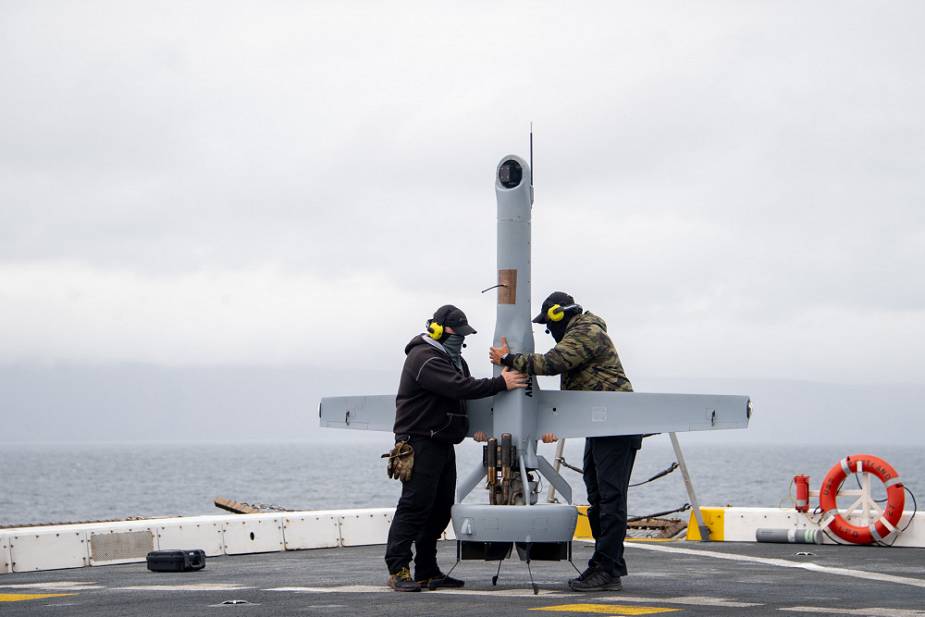According to pictures published by the United States Department of Defense on April 13, 2021, Martin UAV, a leading advanced aviation technology manufacturer in the United States has conduct flight tests of its V-Bat vertical take-off and landing unmanned aerial vehicle from the US Navy USS Portland (LPD 27) landing platform dock ship.
Follow Navy Recognition on Google News at this link
 Ryan Pullen, left, and Joshua Fasnacht, representatives from Martin UAV, prepare a V-Bat vertical take-off and landing unmanned aerial vehicle for launch on the flight deck of amphibious transport dock USS Portland (LPD 27), April 13., 2021. (Picture source U.S. DoD)
Ryan Pullen, left, and Joshua Fasnacht, representatives from Martin UAV, prepare a V-Bat vertical take-off and landing unmanned aerial vehicle for launch on the flight deck of amphibious transport dock USS Portland (LPD 27), April 13., 2021. (Picture source U.S. DoD)
In November 2020, Martin UAV successfully demonstrated the shipboard integration of its V-BAT as well as its impressive maritime capabilities in support of United States Southern Command’s (SOUTHCOM) counter-narcotics operations in the Eastern Pacific from October 6, 2019, to July 31, 2020.
In February 2021, Kongsberg Geospatial announced that it has been selected by Defence Research and Development Canada (DRDC) to conduct trials of a new long-endurance UAV (Unmanned Aerial Vehicle) V-BAT surveillance system for the Canadian Coast Guard.
The V-Bat is a vertical take-off and landing (VTOL) unmanned aerial vehicle (UAV) designed and developed by the American company Martin UAV. This type of UAV can be used to conduct a wide range of military missions such as aerial patrol, search and detection of targets, surveillance, shipboard operation, aerial mapping, urban monitoring, autonomous delivery, and placement of payloads.
The V-BAT Unmanned Aerial System (UAS) is designed to operate from very small spaces on ships, land, and nearly any environment. The V-BAT is a long-endurance aircraft capable of carrying multiple sensors, including land and maritime wide-area surveillance.
The V-Bat VTOL aerial system design features fixed wings and a slender fuselage. It is powered by a 157 cc, two-stroke engine, which generates an output power of 13 hp. The drone can fly at a maximum speed of 90 knots and offers a range of 300 nautical miles. It can operate at an altitude of 15,000 feet and in wind speeds up to 25 knots. It can perform continuous operations for up to eight hours at a speed of 40 knots.
The USS Portland (LPD-27) is a San Antonio-class amphibious transport dock ship in service with the United States Navy. An amphibious transport dock also called a landing platform/dock (LPD), is an amphibious warfare ship that embarks, transports, and lands elements of a landing force for expeditionary warfare missions. The ship incorporates both a flight deck and a well deck that can be ballasted and deballasted to support landing craft or amphibious vehicles.
The landing deck of USS Portland is able to accommodate two Sikorsky CH-53E Sea Stallion helicopters, six Bell AH-1W Super Cobra helicopters, four Boeing CH-46 Sea Knight helicopters, or two Boeing Bell MV-22 Osprey tiltrotor aircraft. It has also a hangar with the place for one Sea Stallion, two Sea Knights, three Super Cobra helicopters or one MV-22 Osprey tiltrotor aircraft.



